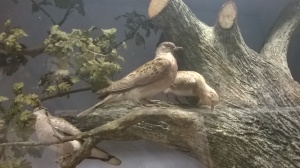I was in Brighton today and visited the Booth Museum of Natural History, which I haven’t been to for maybe 15 years. It is an incredible collection, but my visit also felt so catastrophically sad.
The core of the museum is the collection of stuffed birds in specially-constructed dioramas made in the second half of the nineteenth century by Edward Booth. His aim was to collect examples of all the British birds, and that includes an amazing number of rare migrants, most cases carefully labelled to indicate where and when they were caught, many of them in Sussex. I don’t have that much of a problem with the fact that Edward Booth caught all those birds, since that was not such unusual behaviour then, though he does seem to have been extremely obsessive and a bit odd.[1] Even so, I did wonder quite what was going through his head as he killed animals which may have been the first (or, quite possibly, last) individual ever seen in this country.
Nevertheless, the collection is a shocking reminder of how much habitat loss, modern farming practice, disease and climate change have impacted so many species in the last hundred years. Though some species have increased in abundance, as I walked around I couldn’t help but think of the species that have declined, often dramatically in that period.
This was abundantly clear in the case of the Turtle Dove (Streptopelia turtur), which used to be common, as the label by the case noted. These birds were caught at Portslade in 1872.
It is now very unusual to see a Turtle Dove, as Bruce Fowkes of the RSPB made clear at the recent Adastra meeting organised by the Sussex Biodiversity Record Centre. Operation Turtle Dove is a project that aims to reverse the massive diminution in the population of this species, though the graph he showed us wasn’t encouraging:
A dangerous mix of reduced forage in their European summer habitats, intensification of farming practice in their west African wintering grounds, disease, and hunting on their migratory routes has combined to potentially this species extinct in our lifetimes.
I can imagine the curators of the museum have a huge amount to do, but I wondered if there was a potential missed opportunity here: I certainly would have found the exhibits even more interesting if they bore additional labels to indicate their current population status relative to Booth’s time. There is arguably a danger in seeing collections like this as simply a static representation of ‘British birds’ and, without any context, assuming that nothing has changed in the last hundred years.
Anyway, it is an amazing museum, affording plenty of opportunities to learn stuff, some of especially basic. For instance, looking at the pictures in field guides, I really had no idea that the Duke of Burgundy butterfly (Hamearis lucina) was quite so small. Scale is a tricky thing to convey in books sometimes…
It was interesting too to see a traditional collection of British moths, even if now somewhat faded, and remember the excitement of seeing a couple of Jersey Tigers at Gatwick last year (Euplagia quadripunctaria). Even though there is sadness at the loss we have caused to the natural world, it is important to cling on to what we have left. There is still some nice stuff to see.
[1] “Edward Booth.” Booth Museum of Natural History. Royal Pavilion and Museums, Brighton and Hove, n.d. Web. 23 Feb. 2016. <http://brightonmuseums.org.uk/booth/about/edward-booth/>.





















